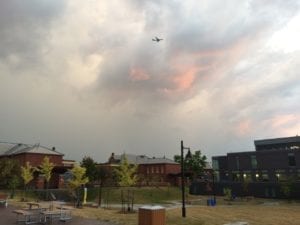Documents from Toronto Pearson noise management forum meetings bring to mind November 2019 Atlantic article about noise
The following link is from a recent email from a community engagement initiative of the Greater Toronto Airports Authority, whose email is community.engagement@gtaa.com:
Click here to access previous posts about air traffic noise >

During an Oct. 4, 2017 visit to the Humber College Lakeshore campus, to view a Mental Health Film Series Premiere, it was noted occasionally Air Traffic Noise made its presence known. If you look closely, you will see an aircraft in the sky in this image. You can click on the photo to enlarge it. Jaan Pill photo
Noise, acoustic ecology, and ‘soundwalks’
I recently read a November 2019 Atlantic article entitled: “Why Everything Is Getting Louder: The tech industry is producing a rising din. Our bodies can’t adapt.”
An excerpt (I have broken the text into shorter paragraphs) reads:
Most ordinances correlate punishable noise with loudness, though if you’ve ever tried to sleep through a dripping faucet, you know that something can be quiet and still drive you up the wall. Research confirms that what makes a sound annoying is only partially whether it whispers or roars.
The volume at which noise begins to irritate varies depending on the source—we tolerate trains at louder volumes than cars, and cars at louder volumes than planes—and its pitch, or frequency. (Humans can hear sounds between 20 and 20,000 hertz, which roughly ranges from the low-frequency thump of subwoofers to the high-frequency buzz of certain crickets.)
We are more sensitive to mid-frequency sounds—voices, birdsong, squealing brakes, shrieking infants—and perceive these sounds as louder than they are. Contrary to the stereotype of the old man shaking his fist, age and gender are not necessarily strong predictors of annoyance.
A second excerpt reads:
R. Murray Schafer, a Canadian composer who, in the 1960s, pioneered the field of acoustic ecology, has advocated “soundwalks” as an activity that, even more effectively than ordinances, could curb noise pollution by making people more aware of their habitat’s acoustics.
I have encountered sufficient personas to populate many works of fiction
The topic of noise brings to mind a previous post entitled:
An excerpt reads:
Having moved to Stratford, home of the Stratford Festival of Canada, from time to time I look at things from the perspective of drama, role play, dramaturgy, and fiction.
What characters and personas come to mind when as a former Toronto resident I look at life from a dramaturgical perspective? The link in the previous sentence refers to a definition of personas in the context of user-experience design. A more general definition can be accessed here. Below are a few personas (in the general meaning of the term) that come to mind when I look at land-use planning issues in south Etobicoke, where I lived from 1997 to 2018:
The lot-split / overbuild persona
This is a persona or character type in a category of people who own an old house in Toronto. It may have been owned a long time, or has been purchased more recently. The expenses are daunting. There are old houses all around with lots of room around them. “What can I do?” asks the owner.
The persona who understands data analysis
Some people understand that quantitative analysis of qualitative aspects of reality is available for each of us, if we have the requisite human capital to proceed. Residents adept at such analysis are rare; they possess a high level of human capital, and are a source of tremendous inspiration for me.
The persona (character type) whose capacity for human agency is awesome or limited, as the case may be
The persona – character type – who has traction is going to have a sense – based on personal capabilities, education, and experience in the wider world – of the wider picture. Without that, what I observe is a spinning of the wheels.
Each of us is on a continuum, from a low to high level of human agency, with regard to any topic or issue. Agency expresses itself in a wide range of ways, depending on circumstances, and surprises in how agency manifests itself are not uncommon. Whatever our level of human agency, each of us has a role to play. We are all performers and the world is, indeed, our stage.
Air traffic noise unites many people
Lot-split / overbuilding enthusiasts – as well as opponents – are at times concerned about air traffic noise. A persona or character type in favour of lot splitting and overbuilding can explain how to push a project through the committee of adjustment, in the face of opposition from fellow residents. The same character type may also be very concerned about the effect that air traffic noise has on her or his quality of life.
The wider topic is public relations
The ongoing Toronto Pearson communications with the wider public brings to mind the topic of public relations; a previous post which highlights the role of public relations in everyday life is entitled:

Leave a Reply
Want to join the discussion?Feel free to contribute!